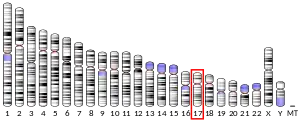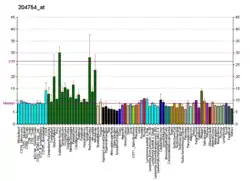Hepatic leukemia factor is a protein that in humans is encoded by the HLF gene.[5][6]
Function
This gene encodes a member of the proline and acidic-rich (PAR) protein family, a subset of the bZIP transcription factors. The encoded protein forms homodimers or heterodimers with other PAR family members and binds sequence-specific promoter elements to activate transcription. Chromosomal translocations fusing portions of this gene with the E2A gene cause a subset of childhood B-lineage acute lymphoid leukemias. Alternatively spliced transcript variants have been described, but their biological validity has not been determined.[6]
References
- 1 2 3 GRCh38: Ensembl release 89: ENSG00000108924 - Ensembl, May 2017
- 1 2 3 GRCm38: Ensembl release 89: ENSMUSG00000003949 - Ensembl, May 2017
- ↑ "Human PubMed Reference:". National Center for Biotechnology Information, U.S. National Library of Medicine.
- ↑ "Mouse PubMed Reference:". National Center for Biotechnology Information, U.S. National Library of Medicine.
- ↑ Inaba T, Roberts WM, Shapiro LH, Jolly KW, Raimondi SC, Smith SD, Look AT (July 1992). "Fusion of the leucine zipper gene HLF to the E2A gene in human acute B-lineage leukemia". Science. 257 (5069): 531–4. Bibcode:1992Sci...257..531I. doi:10.1126/science.1386162. PMID 1386162.
- 1 2 "Entrez Gene: HLF hepatic leukemia factor".
Further reading
- LeBrun DP (May 2003). "E2A basic helix-loop-helix transcription factors in human leukemia". Frontiers in Bioscience. 8: s206-22. doi:10.2741/1030. PMID 12700034.
- Hunger SP, Ohyashiki K, Toyama K, Cleary ML (September 1992). "Hlf, a novel hepatic bZIP protein, shows altered DNA-binding properties following fusion to E2A in t(17;19) acute lymphoblastic leukemia". Genes & Development. 6 (9): 1608–20. doi:10.1101/gad.6.9.1608. PMID 1516826.
- Falvey E, Fleury-Olela F, Schibler U (September 1995). "The rat hepatic leukemia factor (HLF) gene encodes two transcriptional activators with distinct circadian rhythms, tissue distributions and target preferences". The EMBO Journal. 14 (17): 4307–17. doi:10.1002/j.1460-2075.1995.tb00105.x. PMC 394515. PMID 7556072.
- Hunger SP, Brown R, Cleary ML (September 1994). "DNA-binding and transcriptional regulatory properties of hepatic leukemia factor (HLF) and the t(17;19) acute lymphoblastic leukemia chimera E2A-HLF". Molecular and Cellular Biology. 14 (9): 5986–96. doi:10.1128/mcb.14.9.5986. PMC 359124. PMID 8065331.
- Inaba T, Shapiro LH, Funabiki T, Sinclair AE, Jones BG, Ashmun RA, Look AT (May 1994). "DNA-binding specificity and trans-activating potential of the leukemia-associated E2A-hepatic leukemia factor fusion protein". Molecular and Cellular Biology. 14 (5): 3403–13. doi:10.1128/mcb.14.5.3403. PMC 358705. PMID 8164688.
- Hunger SP (February 1996). "Chromosomal translocations involving the E2A gene in acute lymphoblastic leukemia: clinical features and molecular pathogenesis". Blood. 87 (4): 1211–24. doi:10.1182/blood.v87.4.1211.bloodjournal8741211. PMID 8608207.
- Andersson B, Wentland MA, Ricafrente JY, Liu W, Gibbs RA (April 1996). "A "double adaptor" method for improved shotgun library construction". Analytical Biochemistry. 236 (1): 107–13. doi:10.1006/abio.1996.0138. PMID 8619474.
- Hunger SP, Li S, Fall MZ, Naumovski L, Cleary ML (June 1996). "The proto-oncogene HLF and the related basic leucine zipper protein TEF display highly similar DNA-binding and transcriptional regulatory properties". Blood. 87 (11): 4607–17. doi:10.1182/blood.V87.11.4607.bloodjournal87114607. PMID 8639829.
- Yu W, Andersson B, Worley KC, Muzny DM, Ding Y, Liu W, Ricafrente JY, Wentland MA, Lennon G, Gibbs RA (April 1997). "Large-scale concatenation cDNA sequencing". Genome Research. 7 (4): 353–8. doi:10.1101/gr.7.4.353. PMC 139146. PMID 9110174.
- Takahata S, Sogawa K, Kobayashi A, Ema M, Mimura J, Ozaki N, Fujii-Kuriyama Y (July 1998). "Transcriptionally active heterodimer formation of an Arnt-like PAS protein, Arnt3, with HIF-1a, HLF, and clock". Biochemical and Biophysical Research Communications. 248 (3): 789–94. doi:10.1006/bbrc.1998.9012. PMID 9704006.
- Inukai T, Inaba T, Ikushima S, Look AT (October 1998). "The AD1 and AD2 transactivation domains of E2A are essential for the antiapoptotic activity of the chimeric oncoprotein E2A-HLF". Molecular and Cellular Biology. 18 (10): 6035–43. doi:10.1128/mcb.18.10.6035. PMC 109189. PMID 9742120.
- Begbie M, Mueller C, Lillicrap D (February 1999). "Enhanced binding of HLF/DBP heterodimers represents one mechanism of PAR protein transactivation of the factor VIII and factor IX genes". DNA and Cell Biology. 18 (2): 165–73. doi:10.1089/104454999315556. PMID 10073576.
- Ema M, Hirota K, Mimura J, Abe H, Yodoi J, Sogawa K, Poellinger L, Fujii-Kuriyama Y (April 1999). "Molecular mechanisms of transcription activation by HLF and HIF1alpha in response to hypoxia: their stabilization and redox signal-induced interaction with CBP/p300". The EMBO Journal. 18 (7): 1905–14. doi:10.1093/emboj/18.7.1905. PMC 1171276. PMID 10202154.
- Honda H, Inaba T, Suzuki T, Oda H, Ebihara Y, Tsuiji K, Nakahata T, Ishikawa T, Yazaki Y, Hirai H (May 1999). "Expression of E2A-HLF chimeric protein induced T-cell apoptosis, B-cell maturation arrest, and development of acute lymphoblastic leukemia". Blood. 93 (9): 2780–90. doi:10.1182/blood.v93.9.2780.409a47_2780_2790. PMID 10216071.
- Matsunaga T, Inaba T, Matsui H, Okuya M, Miyajima A, Inukai T, Funabiki T, Endo M, Look AT, Kurosawa H (April 2004). "Regulation of annexin II by cytokine-initiated signaling pathways and E2A-HLF oncoprotein". Blood. 103 (8): 3185–91. doi:10.1182/blood-2003-09-3022. PMID 15070701. S2CID 12473166.
External links
- HLF+protein,+human at the U.S. National Library of Medicine Medical Subject Headings (MeSH)
This article incorporates text from the United States National Library of Medicine, which is in the public domain.
This article is issued from Wikipedia. The text is licensed under Creative Commons - Attribution - Sharealike. Additional terms may apply for the media files.






